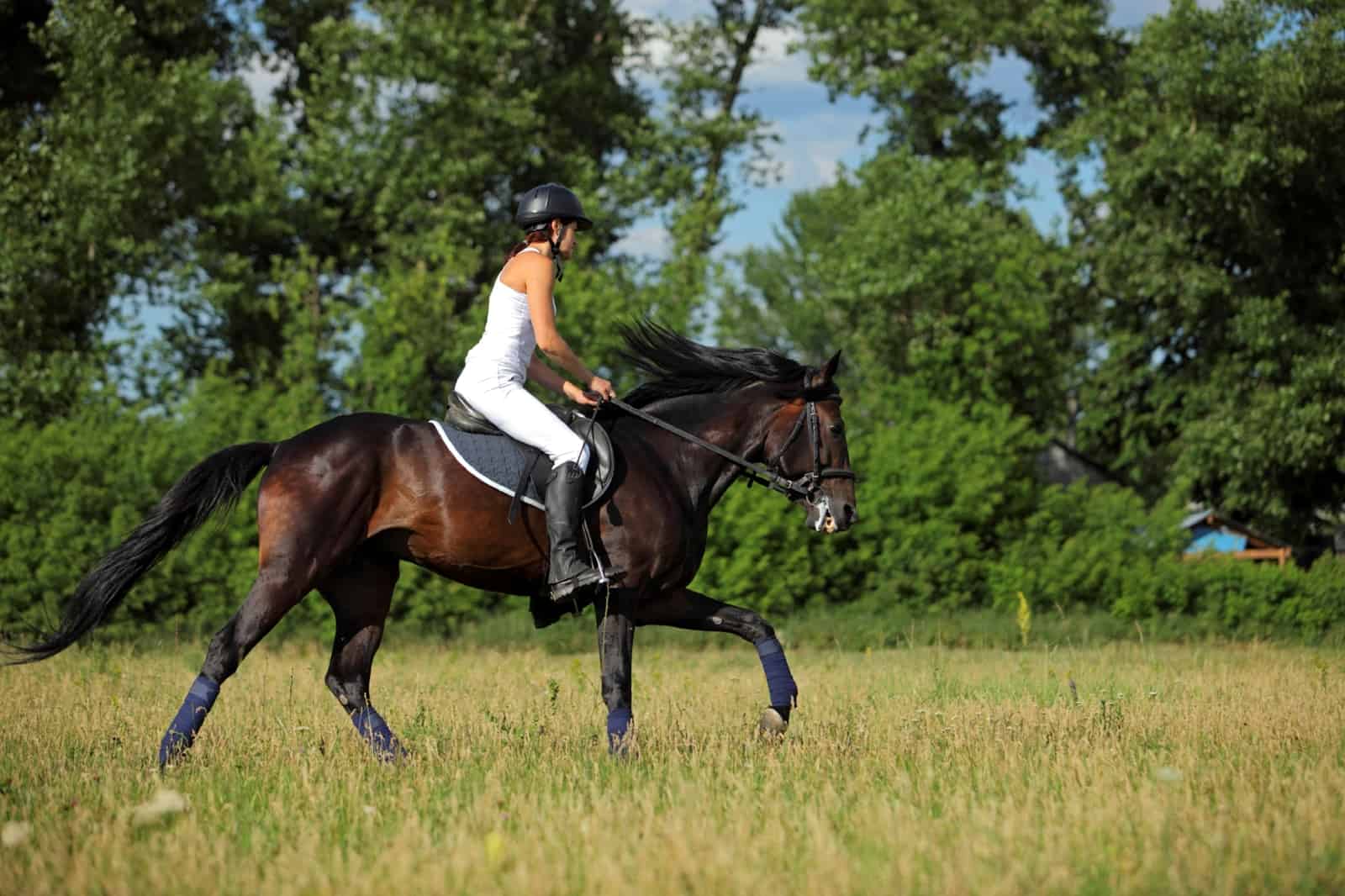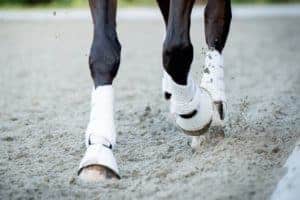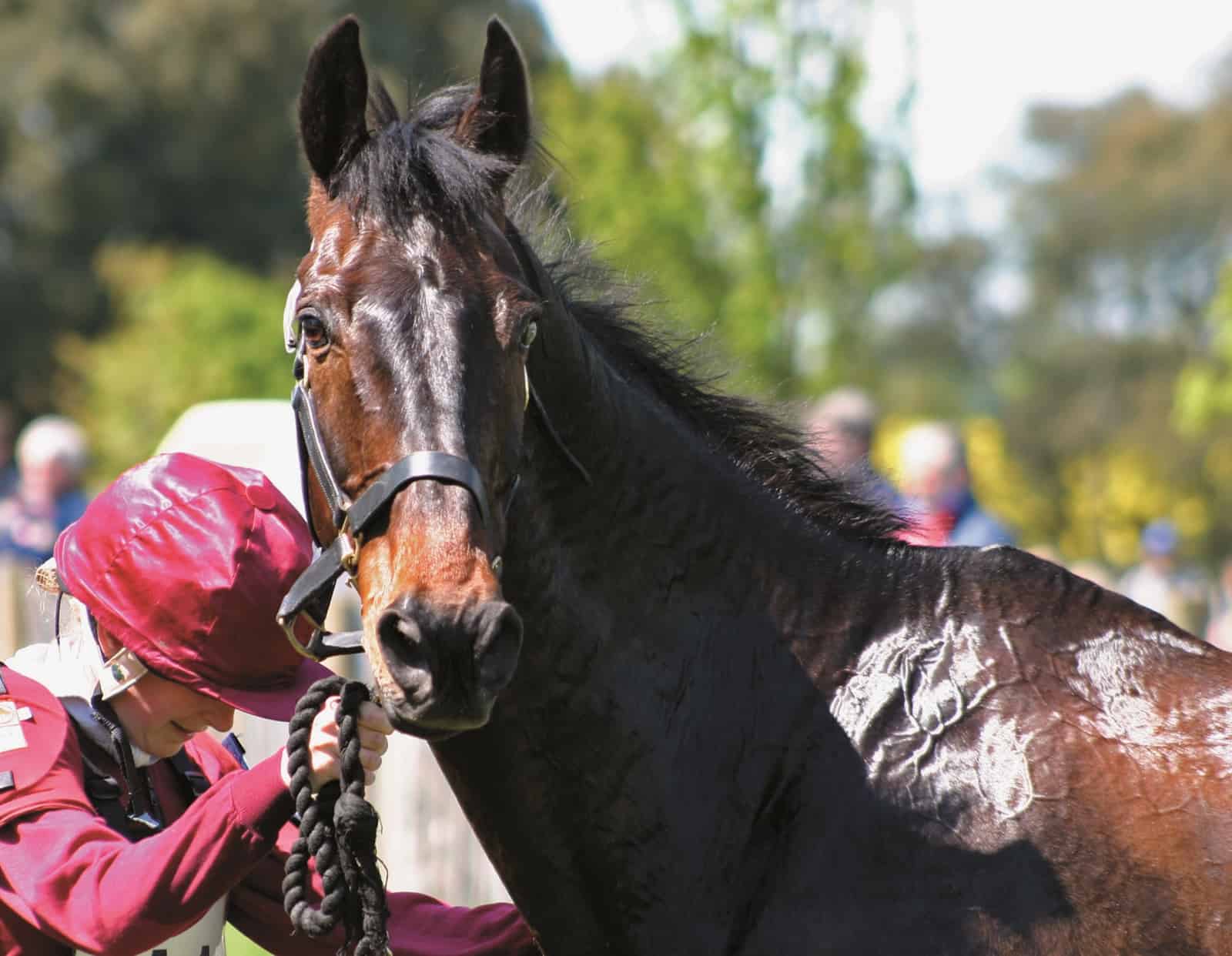Conditioning Horses Through the Seasons: Spring and Summer
- Topics: Article, Cardiovascular System, Conditioning, Conditioning For Competition, Conditioning Through the Seasons, Conditioning Young Horses, Exercise-Related Conditions, Heart & Cardiovascular Problems, Horse Care, Lameness, Ligament & Tendon Injuries, Ligament & Tendon Injuries, Musculoskeletal System, Recovering from Injury & Surgery, Respiratory System, Sports Medicine

Acclimatizing your riding horse to spring and summer weather conditions requires an understanding of exercise physiology
For many of us, springtime heralds the beginning of warm, sunny days and the start of the competition season. As you plan your spring and summer training schedule, however, keep in mind that your horse’s body will need time to adjust to new demands. Moreover, the way his body adapts to exercise will be affected by seasonal conditions such as heat and humidity. In this article we’ll explore how your horse’s body adapts to exercise training, how he acclimates to spring and summer weather conditions, and what you can do to help him perform at his best.
Exercise Physiology: From the Inside Out
While exercise training causes some changes that will be easy for you to see, such as muscle development, other adaptations aren’t as readily apparent. Below is a summary of some of the changes that occur during exercise training and how environmental conditions affect them. Although this list isn’t comprehensive, it
will give you a good idea of some of the more important effects of exercise on your horse’s body.
Muscles and Tendons
Changes in muscle size and definition are two of the most easily identifiable adaptations to exercise, and they begin to occur at the molecular level within days of the first training session. Tendons, on the other hand, adapt more slowly to the increased demands placed on them by exercise. Several studies have suggested that tendons become thicker with exercise, but this response only occurs in certain tendons and happens over three or more months. This means that even though your horse’s muscles are getting bigger and stronger, his tendons aren’t necessarily keeping pace, and you’ll need to take extra care to keep them from being injured.
“Tendon and ligament injuries are most common when the animal is not in good physical shape,” says Robin Dabareiner, DVM, PhD, Dipl. ACVS, who studies equine lameness at the Texas A&M University College of Veterinary Medicine. “A key point to prevent injuries is to make sure the horse is fit enough for the activity you are performing.”

This is particularly important in the springtime, when heavy rains can lead to deep or uneven footing that can increase the risk of injury. To protect the more commonly injured forelimb flexor tendons (these attach to the digital flexor muscles, which start just behind the elbow and go to just above the knee) and suspensory ligaments (located just in front of the two tendons and behind the cannon bone; these aid in supporting the fetlocks), Dabareiner recommends tendon boots with straps that wrap around the fetlock to provide support. Researchers showed Dalmar tendon boots (carbon fiber composite exercise boots), which use a similar design, prevent fetlock overextension (RKW Smith et al. Equine Veterinary Journal 2002;34:726-731.), while traditional neoprene sports medicine boots used in the same study do not.
Bones
Research has shown that the long bones (those that are longer than they are wide and aid in locomotion, store minerals, and act as levers) of the equine forelimb become thicker and denser with exercise. The extent of this adaptation depends on the type of surface the horse trains on, with less adaptation observed in horses that train on softer surfaces. Adaptation also depends upon the types of workouts the horse is completing, as short sprints increase bone mineral content more effectively than long, slow distance work.
Stall rest can decrease bone mineral density, which is important to remember if you’re bringing your horse back from an injury or a winter layoff. Bone density changes can occur over the course of two to three months so, just like tendons, bones are particularly susceptible to injuries during the first few months of training.
Cardiovascular System
The cardiovascular system adapts quickly and effectively to aerobic exercise so that it can provide sufficient blood flow to contracting muscle. With training, the heart’s size and stroke volume (volume of blood pumped with each beat) increase, which allows the heart to pump more efficiently. The number of capillaries in skeletal muscle also increases to improve the exchange of oxygen and carbon dioxide between the blood and the muscle fibers.

High ambient temperatures cause the horse’s body to divert blood from the skeletal muscle, sending it to the skin. The heat that an exercising horse produces is then primarily dissipated through the skin by sweating—this helps keep a horse’s core body temperature lower (more on the role of skin in a moment). High ambient temperatures take their toll by increasing sweat production during exercise, which leads to the loss of fluid, electrolytes, and blood volume. In addition, contracting muscle requires large amounts of oxygen and nutrients, and if these needs are not met because blood flow is going to the skin, the muscle (and your horse) fatigues quickly.
Acclimation to exercise in a hot environment takes about two weeks and includes adaptations such as increased blood volume, a lower heart rate, and more efficient distribution of blood flow. These adaptations decrease the stress on your horse’s body when he’s exercising in the heat and should improve his performance and recovery.
Integumentary System (Skin)
With training, sweating begins at a lower body temperature. The composition of the sweat itself also changes. An unfit horse produces a thick, lathery sweat, which contains high concentrations of protein and ions such as sodium and chloride. In as few as three weeks of training in hot conditions, the total volume of sweat a horse produces decreases, as does the ion content. This allows him to retain valuable fluids and electrolytes, preserving the blood volume necessary to supply exercising muscle and helping prevent dehydration.
Respiratory System
Although the respiratory system itself is generally not a limiting factor in exercise performance, horses can have performance-limiting respiratory allergies that are exacerbated by springtime pollen. Horses with recurrent airway obstruction (RAO, or heaves) are particularly sensitive to allergens such as pollen, molds, and fungi. The allergens are inhaled and can cause irritation, inflammation, and constriction of the small airways, much like asthma in humans. Identifying and eliminating the offending allergen, in combination with regular exercise and good stable management, can reduce or eliminate clinical signs in many horses. Consult your veterinarian about managing your horse’s respiratory problems.

Getting Started
Before you begin training for this year’s show or riding season, you’ll need to make an honest assessment of your horse. If you’ve been able to ride during the winter and your horse has retained a basic level of aerobic fitness, you’ll be able to ramp up his training fairly quickly. On the other hand, if you haven’t been riding and your horse is overweight (or underweight) and out of shape, you’ll need to bring him back much more slowly by gradually increasing the duration and intensity of his workouts throughout the spring. Now is also the time to ensure he’s up-to-date on his vaccinations, deworming, and hoof care and shoeing. Any health problems, no matter how small, should be addressed before you start training. A thorough physical exam by your veterinarian is a good way to ensure your horse is ready to train.
The biggest issue for spring and summer training is, of course, the heat—a stressor for your horse, whether he is exercising or not. A workout that was not overly taxing when performed at 70°F might be extremely strenuous when performed at 95°F. Fortunately, your horse is well-equipped to adapt to the heat and, with a little help from you, he should be able to perform well even during the hottest summer months.
Keeping Track
As a horse enters heavy training, monitor his vital signs consistently before, during, and after exercise, and take note of what “normal” is for him. Heart rate, respiration rate, and temperature are good indicators of how a horse is responding to a workout on a given day and can be used to gauge whether to continue exercising. A horse’s normal heart rate is typically 32-36 beats per minute, but it can increase to about 230 to 240 beats per minute during strenuous exercise; however, a heart rate this high during moderate exercise can be a clue that your horse is dehydrated or overheating.
Taking your horse’s rectal temperature (normally between 99.5-101.5°F) is the best way to assess whether he’s overheated. A temperature above 103°F, combined with clinical signs such as lethargy, lack of interest in his surroundings, and an unwillingness to work, can indicate that it’s time to cut your ride short and cool down your horse.
A normal respiratory rate for adult horses is eight to 12 breaths per minute and can increase to 80-120 breaths per minute immediately post-exercise, depending on the duration and intensity of exercise. The rate will gradually decline in the 30 minutes after exercise, but it can remain elevated longer in hot conditions, so monitor your horse’s breathing for any abnormalities.
While monitoring temperature, pulse, and respiration allow you to observe your horse’s health status during and after a ride, tracking his weight (see TheHorse. com’s online weight calculator tool to estimate your horse’s weight), body condition, and water intake will give you a good idea of whether he is rehydrating between workouts. Weight loss during a ride that is not regained by the next day can indicate that your horse isn’t drinking enough to replenish the water he’s losing while exercising.
Emmett Ross, a long-time endurance competitor and trainer of numerous champion endurance horses, has a veterinarian draw blood for testing his horses’ hematocrit, or the percentage of blood volume taken up by the red blood cells, before and after long training rides. The hematocrit is a very sensitive gauge of hydration and allows Ross to closely monitor how well his elite horses respond to intense workouts. While the average horse owner probably doesn’t need to go to these lengths, Ross emphasizes the importance of tracking and recording objective measurements of a horse’s physiological well-being, especially when asking the horse to perform at or near the limit of his abilities.

Plan Accordingly
A thorough warm-up and cool-down are essential to a good workout, and they can be modified to fit the prevailing weather conditions. Dabareiner recommends a warm-up that transitions progressively from a walk to a trot and then to a lope or canter just until the horse has broken a sweat. For horses coming back from a tendon or ligament injury, she suggests warming up for twice as long as you would with a horse that isn’t injured. When the weather is hot, your horse also will require careful attention after your ride to ensure that he cools down properly. Because body temperature actually rises during the first few minutes after exercise, it is essential that the cool-down not be neglected in hot weather. Ten to 20 minutes of hand walking, hosing with lukewarm water, and using fans will help ensure your horse recovers quickly and efficiently.
During the workout itself, offering water at specific times during your ride will increase the likelihood that your horse will rehydrate. Everyone’s heard the old adage that you can lead a horse to water but you can’t make him drink, but in some cases it’s possible to teach him to do just that. With the Anglo-Arabian mare Ivanhoes Debutante, for instance, Ross breaks up long rides into four-mile intervals and offers her water during two-minute breaks between intervals. He says that, with time, horses will learn to drink when water is offered.
As for duration or intensity of hot weather rides, Ross says the most important aspect in knowing when to push your horse and when to give him a break is experience. Typical signs of overheating or overexertion can include an elevated heart rate and respiration rate (above what is normally seen for a given level of exercise), lethargy, skin tenting (when you pinch skin on your horse’s neck and it doesn’t snap back to normal within seconds), dry skin, and pale mucous membranes, although each horse’s response is slightly different.
“You have to know your horse and know his limits,” advises Ross. “It takes a buildup of two to three years for horses to get to this level (of elite endurance horse fitness). I don’t overdo it.”
Timing is Everything
So when is the best time of day to ride during hot months? While you might prefer to ride in the morning when temperatures are cooler, the humidity is often at its peak early in the day. Depending on where you live, humidity can be a major problem for your horse because it decreases the rate at which sweat evaporates and impairs his body’s ability to cool. This can increase the chances of overheating and dehydration even on days when the absolute temperature isn’t excessively high. One solution to this problem is to ride at night, when the ambient temperature is higher but the relative humidity is much lower. However, keep in mind that you want your horse to adapt to the conditions under which he’ll be competing: If he needs to be able to gallop a cross-country course at 2:00 in the afternoon when the temperature is 90°F, then at least some of his training should take place in those conditions.
Take-Home Message
While training in the spring and summer can present challenges, common sense and a little bit of experience can go a long way toward keeping your horse fit and sound. Your horse’s bones, muscles, tendons, skin, and heart all adapt to exercise at different rates, so it’s important to increase the volume and intensity of training slowly when getting ready for the show season. Monitoring your horse’s fitness and well-being by keeping track of his vital signs, weight, and water consumption is a good way to gauge how well he’s responding to his training regimen.
Written by:
Samantha Steelman, PhD
Related Articles
Stay on top of the most recent Horse Health news with















